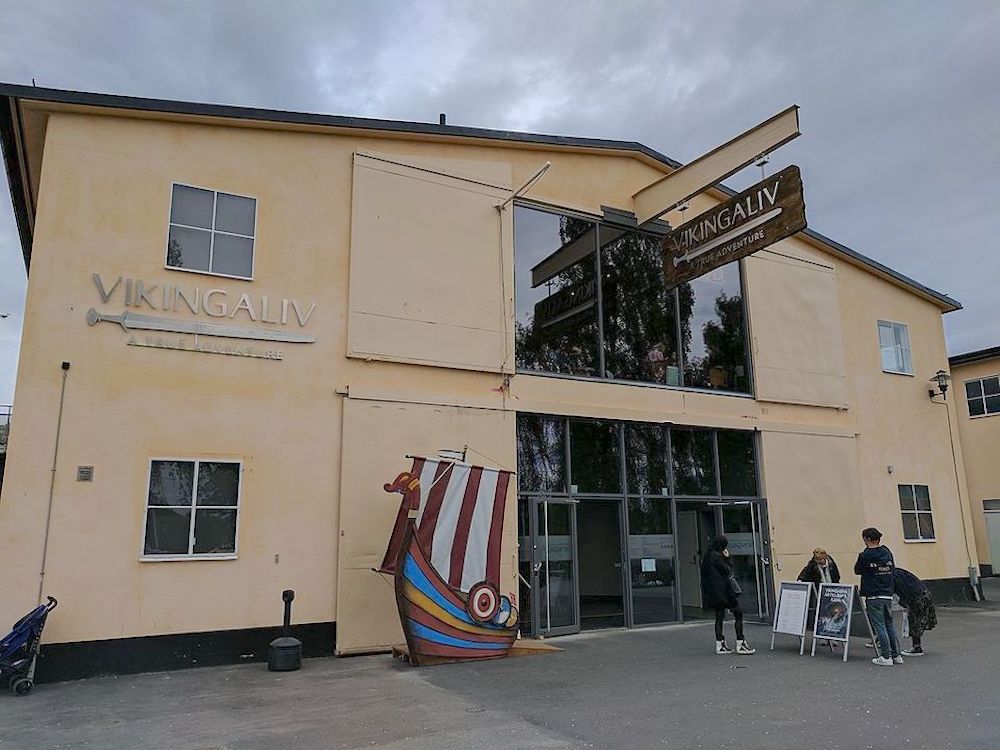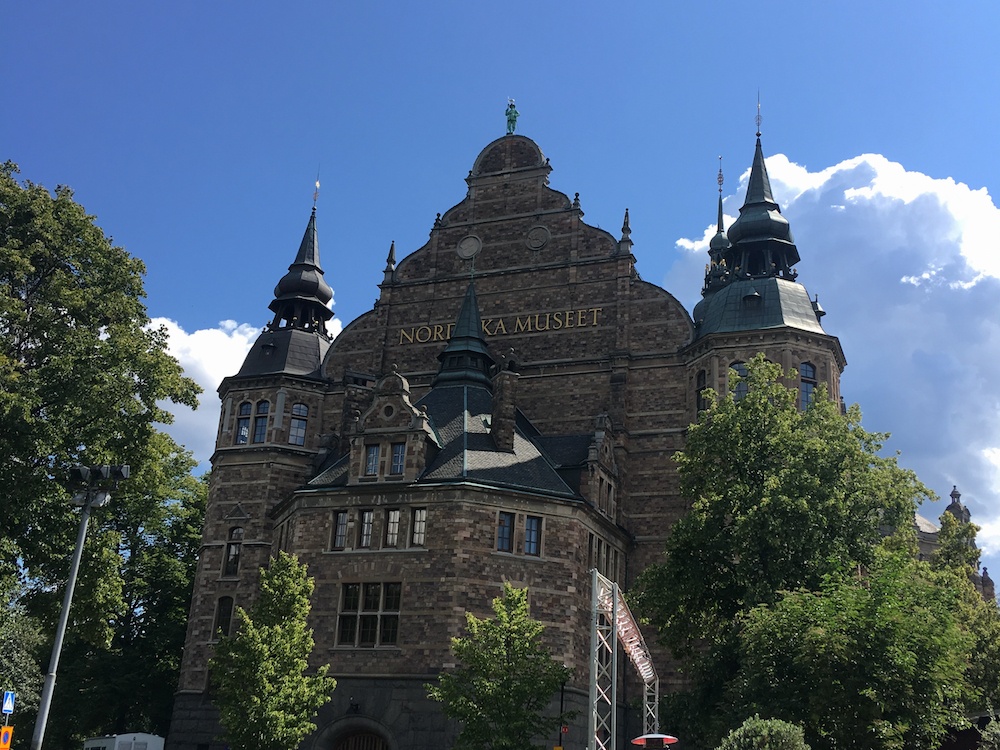
Just Sit right back and you'll hear the tale
the tale of a fateful trip
That started from this Baltic port
aboard this unstable ship.....

 To get to Djurgarden, we took a ferry from
the mainland (photo to the left). The
island is a popular spot for tourists and locals alike, and it
is host to numerous museums. Upon exiting the ship and heading
toward the main street, the first museum we came across is
probably the most famous of the lot, the ABBA museum, shown in
the photo to the right. After Tracy and Morag posed for a photo
in the cutouts of ABBA we headed in the direction of the Vasa
Museum, passing both the Museum of Spirits and the Viking Museum
on the way. As difficult as it was to
pass up a shrine devoted to alcohol consumption and a museum
devoted to men who wore horns on their helmets, we
To get to Djurgarden, we took a ferry from
the mainland (photo to the left). The
island is a popular spot for tourists and locals alike, and it
is host to numerous museums. Upon exiting the ship and heading
toward the main street, the first museum we came across is
probably the most famous of the lot, the ABBA museum, shown in
the photo to the right. After Tracy and Morag posed for a photo
in the cutouts of ABBA we headed in the direction of the Vasa
Museum, passing both the Museum of Spirits and the Viking Museum
on the way. As difficult as it was to
pass up a shrine devoted to alcohol consumption and a museum
devoted to men who wore horns on their helmets, we  pressed
on,
cognizant
pressed
on,
cognizant
 of
our limited time and determined to make the most of our visit to
the maritime museum. The Museum of Spirits is shown in the photo
to the left, while the exterior of the Viking museum is shown in
the photo to the right.
of
our limited time and determined to make the most of our visit to
the maritime museum. The Museum of Spirits is shown in the photo
to the left, while the exterior of the Viking museum is shown in
the photo to the right.
 The Vasa was built to be the mightiest warship in
the Baltic. It featured two decks of cannons, at the insistence
of King Gustav Adolf, and the extra weight high up in the
sterncastle made it very unstable, something that was confirmed
in dockside trials before the ship's inaugural voyage. The ship
took on its cannons at a mooring just below the Tre Kronor
Castle. (illustration to the left) As it passed the castle under
a light breeze, the cannon ports were opened to fire a salute
and they remained open as the ship passed into more open water,
with stiffer breezes. Despite hoisting only 4 of its 10 sails
the breeze proved too much, as the Vasa initially listed to port
and then righted itself, only to be buffeted to port again. This
time the opened gun ports were submerged and water began to pour
into the ship. The Vasa
sank quickly, just 1300 meters from where it was launched. It is
estimated that 30 people lost their lives, a relatively light
mortality rate, as the boat was close to shore and survivors
could be quickly rescued. The Vasa
slipped beneath the water and remained there for 332 years.
The Vasa was built to be the mightiest warship in
the Baltic. It featured two decks of cannons, at the insistence
of King Gustav Adolf, and the extra weight high up in the
sterncastle made it very unstable, something that was confirmed
in dockside trials before the ship's inaugural voyage. The ship
took on its cannons at a mooring just below the Tre Kronor
Castle. (illustration to the left) As it passed the castle under
a light breeze, the cannon ports were opened to fire a salute
and they remained open as the ship passed into more open water,
with stiffer breezes. Despite hoisting only 4 of its 10 sails
the breeze proved too much, as the Vasa initially listed to port
and then righted itself, only to be buffeted to port again. This
time the opened gun ports were submerged and water began to pour
into the ship. The Vasa
sank quickly, just 1300 meters from where it was launched. It is
estimated that 30 people lost their lives, a relatively light
mortality rate, as the boat was close to shore and survivors
could be quickly rescued. The Vasa
slipped beneath the water and remained there for 332 years. The story of the Vasa Museum really began in
1956 when Anders Franzen and Per Edvin Falting located the
wreckage of the Vasa.
Five years later the ship was retrieved from the water to great
international fanfare, and the painstaking work of preserving
the ship began, an effort that would take over seventeen
years. In 1981 a competition for the design of museum to house
the ship was undertaken, and the commission went to Swedish
architects Goren Mannson and Marianne Dahlback. The Vasa was
transferred from its previous location in the Vasa shipyard to
the museum, which was inaugurated by King Karl Gustav XVI on
June 15, 1990. The museum is much more than simply the tale of a
fated ship and a king's hubris. It is a comprehensive look at
the world that gave birth to the Vasa. Naturally, all aspects of the ship's
life are presented--its' creation, demise, and restoration. But
the permanent exhibits go beyond this tale to paint a picture of
the political and social situation of Sweden and its role in
17th century Europe, with a focus on the daily life of commoners
and, in particular, women. All told, the museum paints a
comprehensive portrait of Sweden at during this time period.
The contents of the Vasa museum may be seen by taking the
virtual tour below.
The story of the Vasa Museum really began in
1956 when Anders Franzen and Per Edvin Falting located the
wreckage of the Vasa.
Five years later the ship was retrieved from the water to great
international fanfare, and the painstaking work of preserving
the ship began, an effort that would take over seventeen
years. In 1981 a competition for the design of museum to house
the ship was undertaken, and the commission went to Swedish
architects Goren Mannson and Marianne Dahlback. The Vasa was
transferred from its previous location in the Vasa shipyard to
the museum, which was inaugurated by King Karl Gustav XVI on
June 15, 1990. The museum is much more than simply the tale of a
fated ship and a king's hubris. It is a comprehensive look at
the world that gave birth to the Vasa. Naturally, all aspects of the ship's
life are presented--its' creation, demise, and restoration. But
the permanent exhibits go beyond this tale to paint a picture of
the political and social situation of Sweden and its role in
17th century Europe, with a focus on the daily life of commoners
and, in particular, women. All told, the museum paints a
comprehensive portrait of Sweden at during this time period.
The contents of the Vasa museum may be seen by taking the
virtual tour below. There is
also a version of this tour designed
specifically for VR headsets such as Google
Cardboard, and it works with both iPhone and
Android devices. It may be access by scanning on
the QR code to the left. If you are viewing this
on a mobile phone, you may access the VR tour by
following this
link.
There is
also a version of this tour designed
specifically for VR headsets such as Google
Cardboard, and it works with both iPhone and
Android devices. It may be access by scanning on
the QR code to the left. If you are viewing this
on a mobile phone, you may access the VR tour by
following this
link.
For iOS devices: scan QR code with your device's camera app, tap on the prompt to open Safari. Select "Allow Device Motion" and the next prompt, "Allow Access to Motion Orientation." Turn the device to landscape mode and a split screen will appear. When the screen turns white, swipe up for fullscreen mode, and place in headset. Here is a video of how to do this--it is simpler than it sounds! [The video opens in a new window--close when done to return to this page]
For Android devices: Open the camera app and use the built-in scanner to scan the QR code above. Confirm that you want to open the website, and wait for it to load--it should load in stereo view. Select the fullscreen ("X" option) from the menu at the bottom. Turn the device to landscape mode and you are ready to go. Here is a video of how to do this--it is simpler than it sounds! [The video opens in a new window--close when done to return to this page]
 Following our trip to the Vasa
Museum, we passed the Nordic Museum (photo to the left) on our
way to lunch overlooking the river that separates Djurgarden
from the mainland. While at lunch Tracy left two nearby tables
of Indonesian women gobsmacked by conversing with them in
Bahasa, their native tongue. A view of our vantage point on the
river is shown in the photo to the right. The
Nordic Museum is visible behind the restaurant. Our
thanks to guide and superhost Morag for taking us on this
excursion.
Following our trip to the Vasa
Museum, we passed the Nordic Museum (photo to the left) on our
way to lunch overlooking the river that separates Djurgarden
from the mainland. While at lunch Tracy left two nearby tables
of Indonesian women gobsmacked by conversing with them in
Bahasa, their native tongue. A view of our vantage point on the
river is shown in the photo to the right. The
Nordic Museum is visible behind the restaurant. Our
thanks to guide and superhost Morag for taking us on this
excursion.